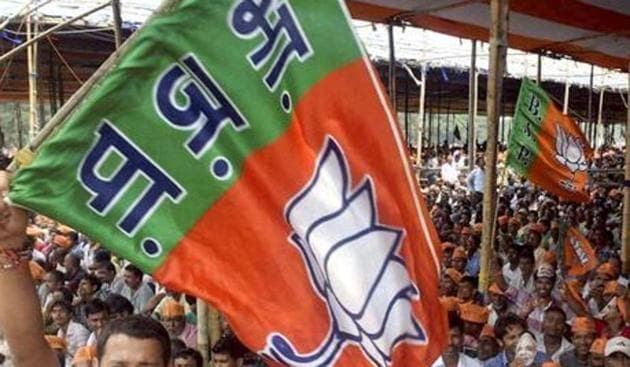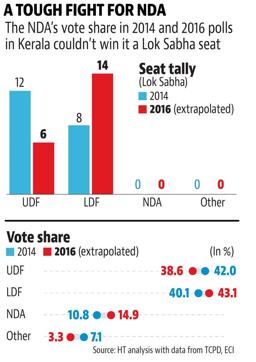Lok Sabha elections 2019: NDA vote share rising in Kerala but will it win them seats?
The Bharatiya Janata Party (BJP) had its first member elected to the Kerala assembly in 2016 when it won the Nemom assembly seat. Will 2019 give the BJP its first Lok Sabha member from Kerala?
The Bharatiya Janata Party (BJP) had its first member elected to the Kerala assembly in 2016 when it won the Nemom assembly seat. Will 2019 give the BJP its first Lok Sabha member from Kerala? The BJP lost the Thiruvananthapuram Lok Sabha seat to the Congress’s Shashi Tharoor by less than 2% of the total votes polled in 2014.

The 2019 general election is the first major one after the Supreme Court’s September judgment allowing the entry of women of childbearing age into the Hindu shrine of Sabarimala, angering traditionalists who believe the presiding deity, Lord Ayyappa, is celibate .
The top court’s order and the ruling Left Democratic Front (LDF) government’s decision to implement it has led to huge protests in the state, which have been backed by both the Congress and the BJP.
An HT analysis looking at the 2014 Lok Sabha and 2016 assembly elections in Kerala suggests that the BJP might not be in the fray in any Lok Sabha seat other than Thiruvananthapuram in the state. The analysis looked at alliance-wise vote shares of the BJP-led National Democratic Alliance (NDA), Communist Party of India (Marxist)-led LDF and the Congress-led United Democratic Front (UDF) in the state.
The NDA finished a distant third in 19 out of the 20 Lok Sabha constituencies in the 2014 elections. The vote share of the winning candidates in 15 of these constituencies was at least 30 percentage points more than the NDA’s. In another four seats, the difference was between 20 and 30 percentage points. In these 19 constituencies, even the vote share of the runners-up was at least 18 percentage points more than the NDA’s.

Things did not change much for the BJP in 2016 assembly elections as well. Even as the NDA’s vote share rose by four percentage points between 2014 and 2016, if the votes were to be extrapolated at the Lok Sabha constituency level, the NDA would again end up winning no seat in the state.
The NDA also lost support in the Thiruvananthapuram Lok Sabha constituency in the 2016 elections, as per the extrapolated results. It finished third with a vote share of 27%, 11 percentage points less than the LDF’s and five percentage points less than the UDF’s.
Do these numbers mean that the BJP has not gained any ground in the state in the post-2014 phase? Even as the headline vote share numbers suggest that it did increase its vote share by four percentage points between the 2009 and 2014 parliamentary and between the 2011 and 2016 state elections, this increase is not enough to take it past the victory mark in all Lok Sabha seats except one.
The question is whether the Sabarimala protests would lead to a drastic realignment of the 55% Hindu vote in the state. If that happens, and there is no way to use historical statistics to analyse this, things could change.
What also needs to be kept in mind is even a small shift of erstwhile UDF and LDF voters towards the BJP could have a large effect on the fortunes of the two major political poles in the state. In 2014, the 20 Lok Sabha members were elected from Kerala with a median average of just 4% vote share margin, compared to the all-India average of 14%. This means the contest between the winner and the runner-up was quite close in a majority of the seats in Kerala.






